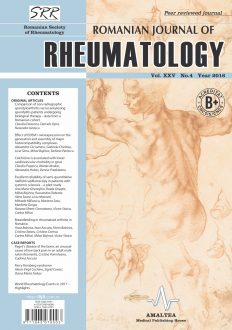SELECT ISSUE

Indexed

| |

|
|
|
| |
|
|
|

|
|
|
|
|
|
| |
|
|
HIGHLIGHTS
National Awards “Science and Research”
NEW! RJR has announced the annually National Award for "Science and Research" for the best scientific articles published throughout the year in the official journal.
Read the Recommendations for the Conduct, Reporting, Editing, and Publication of Scholarly work in Medical Journals.
The published medical research literature is a global public good. Medical journal editors have a social responsibility to promote global health by publishing, whenever possible, research that furthers health worldwide.
Excellent reliability of semi-quantitative nailfold capillaroscopy in patients with systemic sclerosis – a pilot study
Ana Maria Gheorghiu, Raida Oneata, Mihai Bojinca, Rucsandra Dobrota, Alina Soare, Liviu Macovei, Mihaela Milicescu, Mariana Sasu, Marilena Gorga, Roxana Sfrent-Cornateanu, Victor Stoica and Carina Mihai
ABSTRACT
Background. Semi-quantitative nailfold capillaroscopy (NFC) scoring represents a promising tool for assessing disease activity, severity and change in systemic sclerosis (SSc), however there is no consensus yet over which capillaroscopy abnormalities should be analyzed and how.
Objective. Investigation of the reliability of the qualitative and semi-quantitative scoring of NFC assessment between two raters and test-retest for each rater in a SSc cohort.
Methods. This is a single-center pilot study where 2 raters assessed the NFC images of 48 consecutive patients with SSc. Data were analyzed in 3 ways: 1. Qualitatively by “normal”/“abnormal” category; 2. Qualitatively by the following categories: “early”, “active”, “late” SSc patterns, “normal”, and unclassifiable in any pattern, and step; 3. Semi-quantitatively by calculating the mean score for capillary loss, disorganization of the microvascular array, giant capillaries, microhaemorrhages and capillary ramifications and combinations of giant capillaries and microhaemorrhages (as a surrogate for vascular activity). Disorganization and ramifications (surrogate for vascular damage) were also assessed. Variables for all steps were calculated for all fingers and for each finger. Inter-rater/intra-rater agreement was assessed by Cohen’s kappa coefficients for qualitative variables and by intraclass correlation coefficients (ICC) for mean score values of abnormalities.
Results. Inter-rater reliability ranged from good to excellent agreement for mean score values of abnormalities in all fingers (ICC coefficients 0.745 to 0.897) and was excellent for activity (ICC coefficient of 0.923) and damage combinations (ICC coefficient of 0.918). Assessment of abnormalities in a qualitative manner (normal/abnormal or with capillaroscopy patterns) showed weaker inter-rater agreement than the semi-quantitative assessment (k coefficient <0.7). Intra-rater variability was good to excellent for mean score values of abnormalities and activity and damage combinations in all fingers and separate fingers for both raters; for qualitative assessment, only one of the raters had good test-retest reliability.
Conclusion. Reliability of NFC assessment is essential in SSc trials/clinical practice to ensure quality of data. This pilot study demonstrates very good reliability between raters of the semi-quantitative NFC assessment in a SSc cohort. Combinations of NFC abnormalities had very good reliability and might be preferred because they are less time consuming.
Keywords: systemic sclerosis, capillaroscopy, agreement, reliability, quantitative
Full text | PDF
